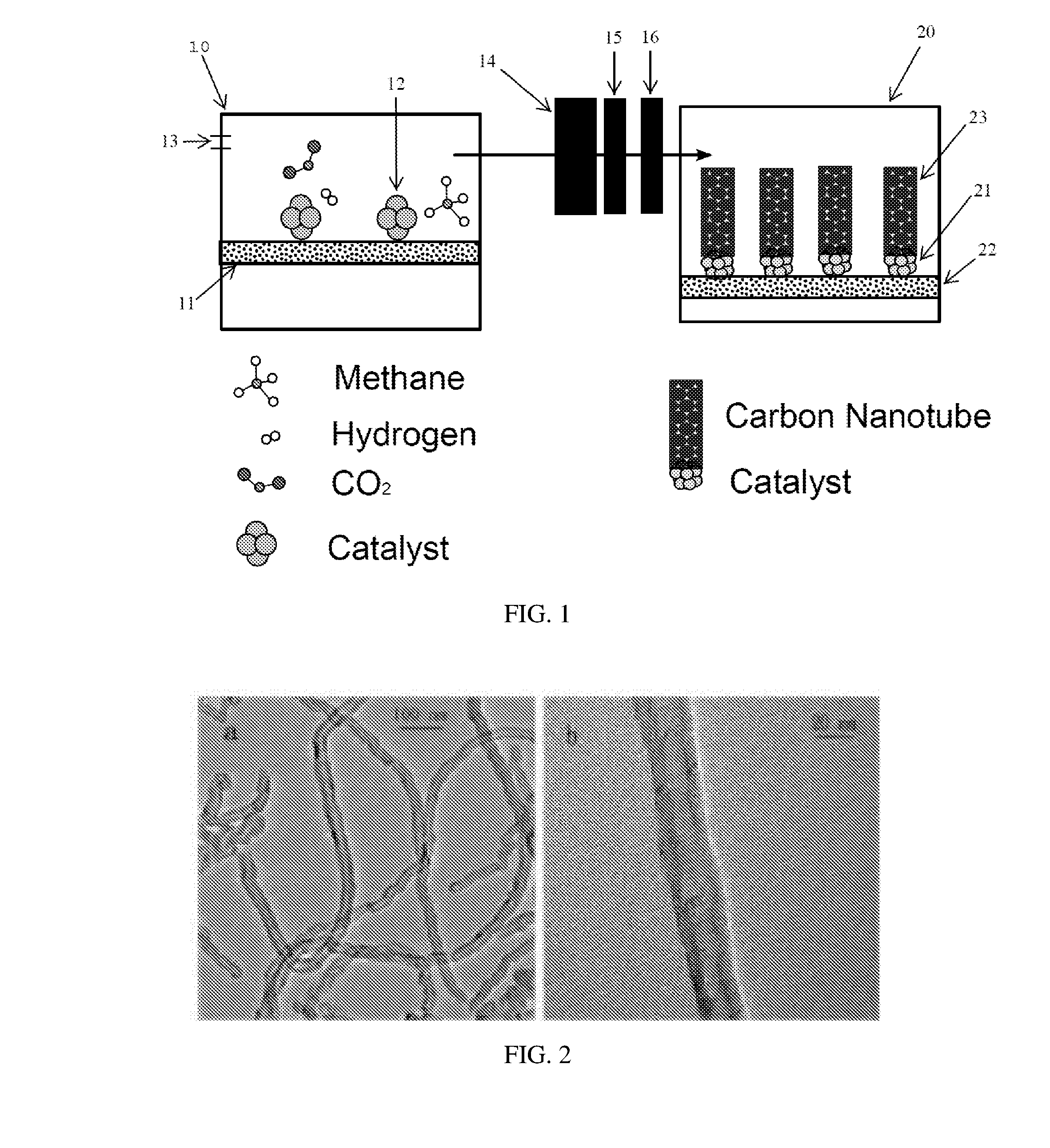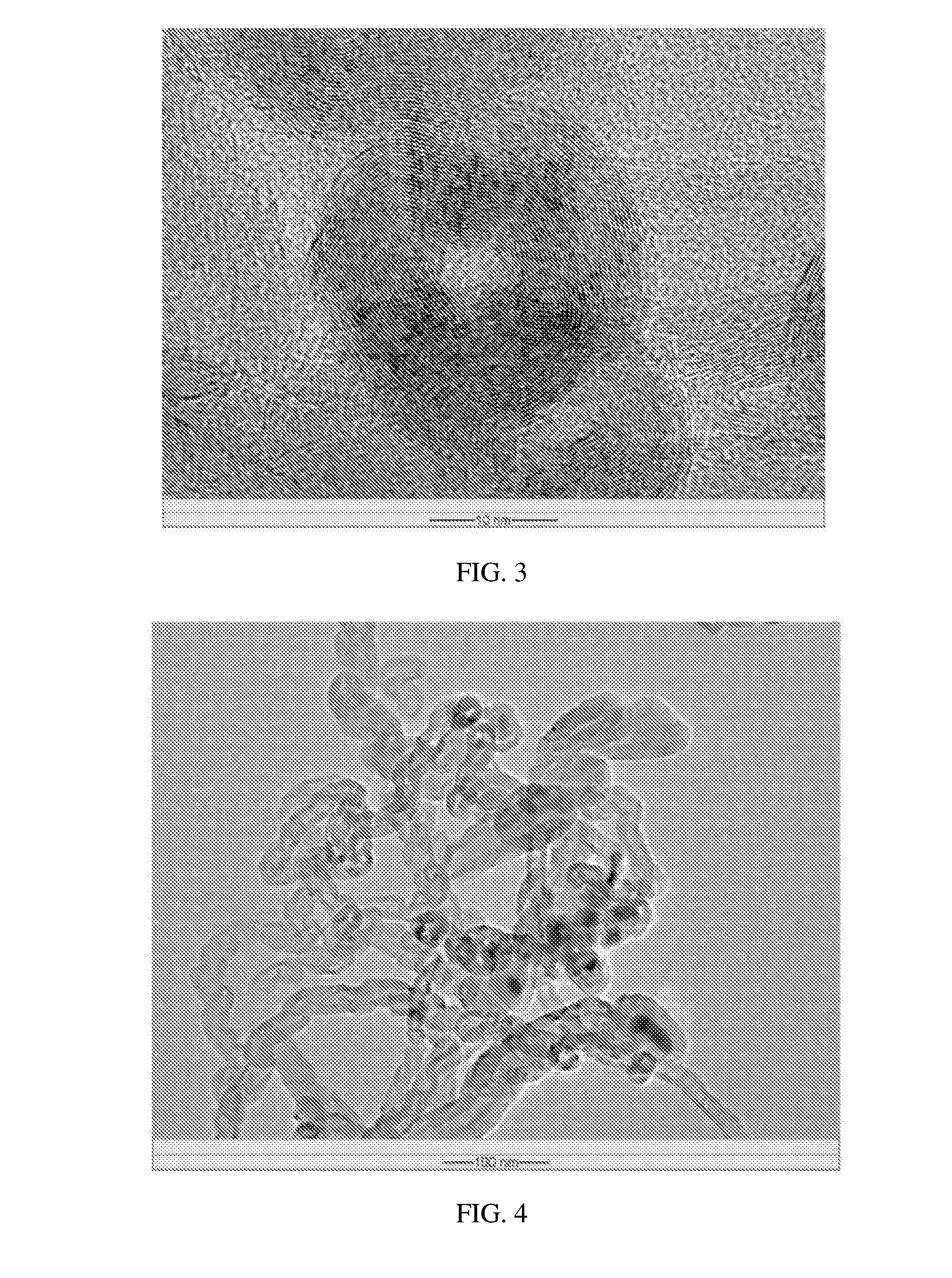Carbon nano-tube production from carbon dioxide
a carbon dioxide and carbon nanotube technology, applied in the direction of single-walled nanotubes, coatings, chemistry apparatus and processes, etc., can solve the problems of large amount of carbon dioxide, failure to efficiently decompose carbon dioxide, and high cost of methane as a direct source, and achieve the effect of high carbon dioxide conversion ra
- Summary
- Abstract
- Description
- Claims
- Application Information
AI Technical Summary
Benefits of technology
Problems solved by technology
Method used
Image
Examples
example 1
Carbon Dioxide Conversion and Carbon Nanotube Production
[0036]Example 1 references FIG. 1 for illustrative purposes. A nickel-based catalyst 12 was synthesized by a citric acid combustion method to produce powders (see Ran M F, Liu Y, Chu W, Liu Z B, Borgna A. Catal Commun, 2012, 27: 69; Ran M F, Sun W J, Liu Y, Chu W, Jiang C F. J Solid State Chem, 2013, 197: 517; Wen J, Chu W, Jiang C F, Tong D G. J Nat Gas Chem, 2010, 19(2): 156, both of which are incorporated by reference). 500 milligrams (mg) of the catalyst 12 was placed in a ceramic boat 11. The ceramic boat 11 was placed into a quartz reactor 10. The catalyst 12 was reduced in the presence of pure hydrogen at a temperature of 550° C. for a period of 120 minutes. Pure carbon dioxide was fed into the quartz reactor 10 at a flow rate of 15 ml / min or 30 ml / min and hydrogenated to methane and water at a temperature of 300-380° C. for a period of 120 minutes to 360 minutes. The inlet hydrogen flowrate was at about the stoichiometr...
example 2
Characterization of the CO2 Derived CNT Samples and Results
[0041]The samples in Table 1 were characterized by several techniques using XRD, TEM, FT-IR, TG-DTG, etc. (see A. Y. Khodakov, W. Chu and P. Fongarland, Chem Rev, 2007, 107, 1692; W. Chu, P. A. Chernayskii, L. Gengembre, G. A. Pankina, P. Fongarland and A. Y. Khodakov, J Catal, 2007, 252, 215, both of which are incorporated by reference). The X-ray diffraction patterns were measured and collected on an XRD Bruker D8 diffractometer with Cu Ka radiation. Transmission electron microscopy (TEM) images were obtained from a JEOL JEM-2000 FX microscope at 200 kV in National University of Singapore (NUS). The samples were prepared by ultrasonic dispersion in an ethanol solution, placed on a copper TEM grid, and evaporated. Scanning electron microscope (SEM) images were obtained on a Philips FEG XL-30 system. Room temperature micro-Raman scattering analyses were carried out with a Renishaw spectrometer using Ar laser excitation sourc...
example 3
Nickel Catalyst System (Ni-A303) for the CVD-IP Process of MWCNTs Production from Carbon Dioxide and Effects of Reaction Temperature for CVD Process
[0051]For the preparation of another nickel containing catalyst, Ni-A303, the sample precursor was dried at 110° C. for 12 hours (h), and then calcined at 700° C. for 6 h. The second reaction (CVD process) was operated at a temperature in the range of 600° C. to 800° C. (Expt. 15-19).
[0052]To grow nanotubes, the two-step integrated CVD-IP new process has been utilized. Typically, 150 mg CVD catalyst (Ni-A303) in a ceramic boat was placed in the quartz reactor 2, followed by a reduction in pure H2 at 550 C for 60 minutes. Then the CO2 / H2 mixed gas was feed in the integrated process system. The carbon nanotube (MWCNTs) production was performed at different reaction temperature (at one temperature in the range of 600° C. to 800° C.). The inlet carbon dioxide was fixed at a flow rate of 30 ml / min, the MWCNTs growth process lasted for 120 min...
PUM
| Property | Measurement | Unit |
|---|---|---|
| temperature | aaaaa | aaaaa |
| temperature | aaaaa | aaaaa |
| flow rate | aaaaa | aaaaa |
Abstract
Description
Claims
Application Information
 Login to View More
Login to View More - R&D
- Intellectual Property
- Life Sciences
- Materials
- Tech Scout
- Unparalleled Data Quality
- Higher Quality Content
- 60% Fewer Hallucinations
Browse by: Latest US Patents, China's latest patents, Technical Efficacy Thesaurus, Application Domain, Technology Topic, Popular Technical Reports.
© 2025 PatSnap. All rights reserved.Legal|Privacy policy|Modern Slavery Act Transparency Statement|Sitemap|About US| Contact US: help@patsnap.com



